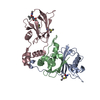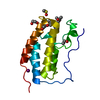+ Open data
Open data
- Basic information
Basic information
| Entry | Database: PDB / ID: 8beb | ||||||
|---|---|---|---|---|---|---|---|
| Title | Ternary complex between VCB, BRD4-BD1 and PROTAC 49 | ||||||
 Components Components |
| ||||||
 Keywords Keywords | LIGASE / PROTAC / degrader / complex / E3 ligase / VHL / VCB | ||||||
| Function / homology |  Function and homology information Function and homology informationregulation of cellular response to hypoxia / RHOBTB3 ATPase cycle / negative regulation of receptor signaling pathway via JAK-STAT / transcription elongation factor activity / target-directed miRNA degradation / elongin complex / Replication of the SARS-CoV-1 genome / VCB complex / Cul5-RING ubiquitin ligase complex / Cul2-RING ubiquitin ligase complex ...regulation of cellular response to hypoxia / RHOBTB3 ATPase cycle / negative regulation of receptor signaling pathway via JAK-STAT / transcription elongation factor activity / target-directed miRNA degradation / elongin complex / Replication of the SARS-CoV-1 genome / VCB complex / Cul5-RING ubiquitin ligase complex / Cul2-RING ubiquitin ligase complex / intracellular membraneless organelle / SUMOylation of ubiquitinylation proteins / RNA polymerase II C-terminal domain binding / P-TEFb complex binding / negative regulation of DNA damage checkpoint / histone H4 reader activity / Pausing and recovery of Tat-mediated HIV elongation / Tat-mediated HIV elongation arrest and recovery / negative regulation of transcription elongation by RNA polymerase II / HIV elongation arrest and recovery / Pausing and recovery of HIV elongation / host-mediated suppression of viral transcription / positive regulation of G2/M transition of mitotic cell cycle / negative regulation of signal transduction / Tat-mediated elongation of the HIV-1 transcript / positive regulation of T-helper 17 cell lineage commitment / Formation of HIV-1 elongation complex containing HIV-1 Tat / ubiquitin-like ligase-substrate adaptor activity / Formation of HIV elongation complex in the absence of HIV Tat / RNA Polymerase II Transcription Elongation / Formation of RNA Pol II elongation complex / : / negative regulation of TORC1 signaling / RNA Polymerase II Pre-transcription Events / RNA polymerase II CTD heptapeptide repeat kinase activity / protein serine/threonine kinase binding / negative regulation of autophagy / transcription corepressor binding / condensed nuclear chromosome / transcription coregulator activity / positive regulation of cell differentiation / TP53 Regulates Transcription of DNA Repair Genes / transcription initiation at RNA polymerase II promoter / transcription elongation by RNA polymerase II / positive regulation of transcription elongation by RNA polymerase II / Vif-mediated degradation of APOBEC3G / Inactivation of CSF3 (G-CSF) signaling / Oxygen-dependent proline hydroxylation of Hypoxia-inducible Factor Alpha / Evasion by RSV of host interferon responses / Regulation of expression of SLITs and ROBOs / cell morphogenesis / ubiquitin-protein transferase activity / p53 binding / transcription corepressor activity / Antigen processing: Ubiquitination & Proteasome degradation / positive regulation of proteasomal ubiquitin-dependent protein catabolic process / chromosome / Neddylation / microtubule cytoskeleton / regulation of gene expression / regulation of inflammatory response / protein-containing complex assembly / Replication of the SARS-CoV-2 genome / ubiquitin-dependent protein catabolic process / histone binding / protein-macromolecule adaptor activity / cellular response to hypoxia / DNA-binding transcription factor binding / molecular adaptor activity / amyloid fibril formation / Potential therapeutics for SARS / proteasome-mediated ubiquitin-dependent protein catabolic process / transcription coactivator activity / positive regulation of canonical NF-kappaB signal transduction / transcription cis-regulatory region binding / protein stabilization / protein ubiquitination / cilium / chromatin remodeling / negative regulation of cell population proliferation / negative regulation of gene expression / protein serine/threonine kinase activity / DNA damage response / ubiquitin protein ligase binding / chromatin binding / regulation of DNA-templated transcription / regulation of transcription by RNA polymerase II / negative regulation of apoptotic process / chromatin / positive regulation of DNA-templated transcription / enzyme binding / endoplasmic reticulum / negative regulation of transcription by RNA polymerase II / positive regulation of transcription by RNA polymerase II / mitochondrion / proteolysis / nucleoplasm / nucleus / plasma membrane / cytosol Similarity search - Function | ||||||
| Biological species |  Homo sapiens (human) Homo sapiens (human) | ||||||
| Method |  X-RAY DIFFRACTION / X-RAY DIFFRACTION /  SYNCHROTRON / SYNCHROTRON /  MOLECULAR REPLACEMENT / MOLECULAR REPLACEMENT /  molecular replacement / Resolution: 3.18 Å molecular replacement / Resolution: 3.18 Å | ||||||
 Authors Authors | Sorrell, F.J. / Mueller, J.E. / Lehmann, M. / Wegener, A. | ||||||
| Funding support |  Germany, 1items Germany, 1items
| ||||||
 Citation Citation |  Journal: Chemmedchem / Year: 2023 Journal: Chemmedchem / Year: 2023Title: Systematic Potency and Property Assessment of VHL Ligands and Implications on PROTAC Design. Authors: Krieger, J. / Sorrell, F.J. / Wegener, A.A. / Leuthner, B. / Machrouhi-Porcher, F. / Hecht, M. / Leibrock, E.M. / Muller, J.E. / Eisert, J. / Hartung, I.V. / Schlesiger, S. | ||||||
| History |
|
- Structure visualization
Structure visualization
| Structure viewer | Molecule:  Molmil Molmil Jmol/JSmol Jmol/JSmol |
|---|
- Downloads & links
Downloads & links
- Download
Download
| PDBx/mmCIF format |  8beb.cif.gz 8beb.cif.gz | 200.4 KB | Display |  PDBx/mmCIF format PDBx/mmCIF format |
|---|---|---|---|---|
| PDB format |  pdb8beb.ent.gz pdb8beb.ent.gz | 157.4 KB | Display |  PDB format PDB format |
| PDBx/mmJSON format |  8beb.json.gz 8beb.json.gz | Tree view |  PDBx/mmJSON format PDBx/mmJSON format | |
| Others |  Other downloads Other downloads |
-Validation report
| Summary document |  8beb_validation.pdf.gz 8beb_validation.pdf.gz | 799.1 KB | Display |  wwPDB validaton report wwPDB validaton report |
|---|---|---|---|---|
| Full document |  8beb_full_validation.pdf.gz 8beb_full_validation.pdf.gz | 803.9 KB | Display | |
| Data in XML |  8beb_validation.xml.gz 8beb_validation.xml.gz | 18.3 KB | Display | |
| Data in CIF |  8beb_validation.cif.gz 8beb_validation.cif.gz | 24.8 KB | Display | |
| Arichive directory |  https://data.pdbj.org/pub/pdb/validation_reports/be/8beb https://data.pdbj.org/pub/pdb/validation_reports/be/8beb ftp://data.pdbj.org/pub/pdb/validation_reports/be/8beb ftp://data.pdbj.org/pub/pdb/validation_reports/be/8beb | HTTPS FTP |
-Related structure data
| Related structure data |  8bdiC  8bdjC  8bdlC  8bdmC  8bdnC  8bdoC  8bdsC  8bdtC  8bdxC  3mxfS  5nw1S S: Starting model for refinement C: citing same article ( |
|---|---|
| Similar structure data | Similarity search - Function & homology  F&H Search F&H Search |
- Links
Links
- Assembly
Assembly
| Deposited unit | 
| ||||||||
|---|---|---|---|---|---|---|---|---|---|
| 1 |
| ||||||||
| Unit cell |
|
- Components
Components
-Protein , 4 types, 4 molecules ABCD
| #1: Protein | Mass: 11748.406 Da / Num. of mol.: 1 Source method: isolated from a genetically manipulated source Source: (gene. exp.)  Homo sapiens (human) / Gene: ELOB, TCEB2 / Production host: Homo sapiens (human) / Gene: ELOB, TCEB2 / Production host:  |
|---|---|
| #2: Protein | Mass: 10974.616 Da / Num. of mol.: 1 Source method: isolated from a genetically manipulated source Source: (gene. exp.)  Homo sapiens (human) / Gene: ELOC, TCEB1 / Production host: Homo sapiens (human) / Gene: ELOC, TCEB1 / Production host:  |
| #3: Protein | Mass: 18702.291 Da / Num. of mol.: 1 Source method: isolated from a genetically manipulated source Source: (gene. exp.)  Homo sapiens (human) / Gene: VHL / Production host: Homo sapiens (human) / Gene: VHL / Production host:  |
| #4: Protein | Mass: 15099.380 Da / Num. of mol.: 1 Source method: isolated from a genetically manipulated source Source: (gene. exp.)  Homo sapiens (human) / Gene: BRD4, HUNK1 / Production host: Homo sapiens (human) / Gene: BRD4, HUNK1 / Production host:  |
-Non-polymers , 3 types, 5 molecules 




| #5: Chemical | ChemComp-SO4 / |
|---|---|
| #6: Chemical | ChemComp-QIK / ( |
| #7: Water | ChemComp-HOH / |
-Details
| Has ligand of interest | Y |
|---|
-Experimental details
-Experiment
| Experiment | Method:  X-RAY DIFFRACTION / Number of used crystals: 1 X-RAY DIFFRACTION / Number of used crystals: 1 |
|---|
- Sample preparation
Sample preparation
| Crystal | Density Matthews: 3 Å3/Da / Density % sol: 59.05 % |
|---|---|
| Crystal grow | Temperature: 277 K / Method: vapor diffusion, sitting drop Details: 1.8M ammonium sulfate, 4% (w/v) glycerol, 0.1M bis-Tris pH5.5 |
-Data collection
| Diffraction | Mean temperature: 100 K / Serial crystal experiment: N |
|---|---|
| Diffraction source | Source:  SYNCHROTRON / Site: SYNCHROTRON / Site:  SLS SLS  / Beamline: X10SA / Wavelength: 0.97626 Å / Beamline: X10SA / Wavelength: 0.97626 Å |
| Detector | Type: DECTRIS PILATUS 6M / Detector: PIXEL / Date: Apr 21, 2022 |
| Radiation | Protocol: SINGLE WAVELENGTH / Monochromatic (M) / Laue (L): M / Scattering type: x-ray |
| Radiation wavelength | Wavelength: 0.97626 Å / Relative weight: 1 |
| Reflection | Resolution: 3.18→64.7 Å / Num. obs: 9832 / % possible obs: 85.4 % / Redundancy: 18.3 % / CC1/2: 0.995 / Rmerge(I) obs: 0.353 / Rpim(I) all: 0.084 / Rrim(I) all: 0.363 / Net I/σ(I): 9.4 |
| Reflection shell | Resolution: 3.18→3.346 Å / Redundancy: 20.9 % / Rmerge(I) obs: 2.206 / Num. unique obs: 493 / CC1/2: 0.512 / Rpim(I) all: 0.492 / Rrim(I) all: 2.261 / % possible all: 41.2 |
-Phasing
| Phasing | Method:  molecular replacement molecular replacement |
|---|
- Processing
Processing
| Software |
| |||||||||||||||||||||||||||||||||||||||||||||||||||||||||||||||||||||||||||||||||||||||||||||||||||||||||||||||||||||||||||||
|---|---|---|---|---|---|---|---|---|---|---|---|---|---|---|---|---|---|---|---|---|---|---|---|---|---|---|---|---|---|---|---|---|---|---|---|---|---|---|---|---|---|---|---|---|---|---|---|---|---|---|---|---|---|---|---|---|---|---|---|---|---|---|---|---|---|---|---|---|---|---|---|---|---|---|---|---|---|---|---|---|---|---|---|---|---|---|---|---|---|---|---|---|---|---|---|---|---|---|---|---|---|---|---|---|---|---|---|---|---|---|---|---|---|---|---|---|---|---|---|---|---|---|---|---|---|---|
| Refinement | Method to determine structure:  MOLECULAR REPLACEMENT MOLECULAR REPLACEMENTStarting model: 5nw1, 3mxf Resolution: 3.18→64.7 Å / Cor.coef. Fo:Fc: 0.907 / Cor.coef. Fo:Fc free: 0.881 / SU B: 61.758 / SU ML: 0.447 / SU R Cruickshank DPI: 0.4791 / Cross valid method: THROUGHOUT / σ(F): 0 / ESU R Free: 0.593 / Stereochemistry target values: MAXIMUM LIKELIHOOD Details: HYDROGENS HAVE BEEN ADDED IN THE RIDING POSITIONS U VALUES : WITH TLS ADDED
| |||||||||||||||||||||||||||||||||||||||||||||||||||||||||||||||||||||||||||||||||||||||||||||||||||||||||||||||||||||||||||||
| Solvent computation | Ion probe radii: 0.8 Å / Shrinkage radii: 0.8 Å / VDW probe radii: 1.2 Å / Solvent model: MASK | |||||||||||||||||||||||||||||||||||||||||||||||||||||||||||||||||||||||||||||||||||||||||||||||||||||||||||||||||||||||||||||
| Displacement parameters | Biso max: 144.5 Å2 / Biso mean: 71.841 Å2 / Biso min: 8.96 Å2
| |||||||||||||||||||||||||||||||||||||||||||||||||||||||||||||||||||||||||||||||||||||||||||||||||||||||||||||||||||||||||||||
| Refinement step | Cycle: final / Resolution: 3.18→64.7 Å
| |||||||||||||||||||||||||||||||||||||||||||||||||||||||||||||||||||||||||||||||||||||||||||||||||||||||||||||||||||||||||||||
| Refine LS restraints |
| |||||||||||||||||||||||||||||||||||||||||||||||||||||||||||||||||||||||||||||||||||||||||||||||||||||||||||||||||||||||||||||
| LS refinement shell | Resolution: 3.18→3.262 Å / Rfactor Rfree error: 0 / Total num. of bins used: 20
| |||||||||||||||||||||||||||||||||||||||||||||||||||||||||||||||||||||||||||||||||||||||||||||||||||||||||||||||||||||||||||||
| Refinement TLS params. | Method: refined / Refine-ID: X-RAY DIFFRACTION
| |||||||||||||||||||||||||||||||||||||||||||||||||||||||||||||||||||||||||||||||||||||||||||||||||||||||||||||||||||||||||||||
| Refinement TLS group |
|
 Movie
Movie Controller
Controller



 PDBj
PDBj















